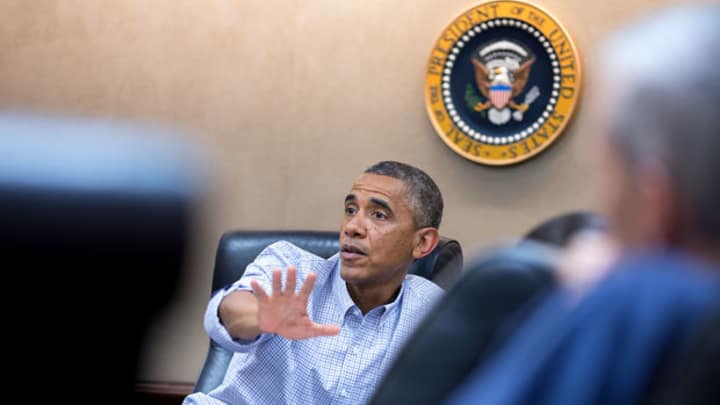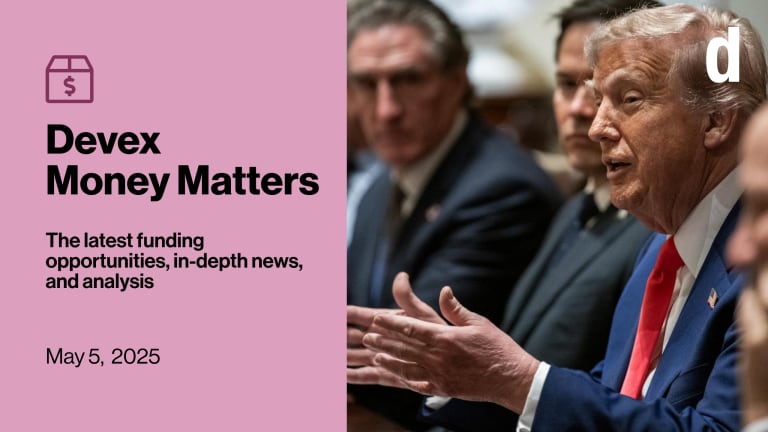
Amid signs that budgetary pressures in Washington are finally easing, U.S. President Barack Obama’s fiscal 2016 budget request this week asks Congress for $54.8 billion in international affairs and foreign aid spending — a modest 2.4 percent increase over current levels.
U.S. administration officials have touted Central America as the big winner in Obama’s fiscal 2016 foreign aid budget request. U.S. development assistance to the region is slated to nearly quadruple to $575 million over fiscal 2014 levels, a fourth-quarter aid pivot for the Obama administration halfway through its second term. It’s worth noting that the region is expected to account for only 4 percent of U.S. bilateral and regional development aid flows in fiscal 2016, up from 1 percent in fiscal 2014.
Deeper analysis of the account-level data in Obama’s fiscal 2016 foreign aid budget request, finds, however, that Central America is far from the only winner in the proposal. In fact, U.S. development aid is expected to increase to every region of the world. While sub-Saharan Africa will continue to claim roughly half of U.S. development funding, the region is also on track to record the smallest percent increase — 6 percent over fiscal 2014 — after the Middle East and North Africa.
See more data analysis of U.S. foreign aid spending:
▪ USAID’s top contractors for 2014
▪ USAID’s top grant implementers for 2014
▪ USAID Forward: Where the local funding is going
▪ USAID’s top local implementing partners
▪ USAID PPPs by the numbers
At the bilateral level, 59 out of 101 U.S. aid recipients are slated for hikes in U.S. development spending over fiscal 2014 — more than the 45 countries in last year’s proposal. With the exception of Europe and Eurasia, the majority of bilateral programs in every region are expected to receive an uptick in U.S. development funding.
Below, Devex breaks down the winners, losers — as well as those countries in-between — in Obama’s fiscal 2016 foreign aid request for bilateral programs. Unless otherwise stated, the proposal is compared with the latest available figures from fiscal 2014. Devex executive members have full access to our dataset on U.S. bilateral aid spending in fiscal 2016 here.

WINNERS
Afghanistan and Iraq
After several years on the chopping block, U.S. development aid flows to Afghanistan and Iraq are set to rise markedly in the fiscal 2016 budget request. Four months after the new unity government in Kabul signed off on a long-delayed U.S.-Afghan security pact, Afghanistan is slated for a 44 percent increase in U.S. development aid. Afghanistan is also the only country to receive more than $1 billion in development aid money, perhaps early indication of an enduring U.S. humanitarian commitment to the war-torn country beyond the expected U.S. troop pullout in 2016.
Top 10 U.S. development aid recipients (fiscal 2016 request)
1. Afghanistan ($1.2 billion)
2. Jordan ($637.4 million)
3. Kenya ($622.3 million)
4. Nigeria ($606.2 million)
5. Tanzania ($589.9 million)
6. Pakistan ($478 million)
7. Ukraine ($460.7 million)
8. Uganda ($458.2 million)
9. Zambia ($415.6 million)
10. Mozambique ($408.8 million)
Figures exclude international security assistance accounts and MCC funding.
Another “front-line state” in U.S. military engagement over the past decade, Iraq is slated for a staggering 314 percent increase in U.S. development aid — bringing the U.S. development aid budget in the country to $72.5 million. The U.S. development funding boost to Baghdad comes four months after Iraq swore in its own new unity government and against the backdrop of U.S.-Iraqi security cooperation against the Islamic State group in northern Iraq. The fiscal 2016 budget request does slash U.S. security assistance to Baghdad — the bulk of the U.S. aid portfolio in Iraq — by 19 percent to $262 million. On the other hand, U.S. security assistance to Afghanistan is hiked by 11 percent to $251.2 million.
South Africa and Namibia
In another apparent change of course of U.S. aid strategy, the fiscal 2016 budget request also sharply increases U.S. development funding to South Africa and Namibia, two focus countries for the U.S. President Emergency Plan for AIDS Relief. Until recently, South Africa and Namibia had seemed to be far along in PEPFAR’s multiyear transition to host country financing and ownership. Botswana, another sub-Saharan African country where that transition is well underway, is however slated for an 8 percent cut in U.S. development aid.
On track for a 32 percent jump, South Africa is expected to see $371.8 million in U.S. development aid in fiscal 2016 — just one year before PEPFAR funding had been initially slated to fall to $250 million. Meanwhile, U.S. development aid to Namibia is set to rise by 85 percent to $43.5 million. PEPFAR funding accounts for the vast majority of U.S. development aid to both South Africa and Namibia.
Ukraine, Moldova and Georgia
In a bid to ”counter Russian pressure and aggressive actions,” the fiscal 2016 budget request also hikes U.S. development aid to three countries in Europe and Eurasia. One year into its standoff with Moscow, Ukraine claims the largest percent increase (527 percent) — bringing U.S. development aid to the country to $460.7 million. Far from the forefront of U.S. aid priorities until recently, Ukraine is now slated to become the seventh largest recipient of U.S. development funding worldwide.
Meanwhile, Moldova and Georgia — two countries which are emerging as battlegrounds in the tit-for-tat between Moscow and Washington — would see increases of 111 percent and 28 percent, respectively. It’s worth noting that Ukraine, Moldova and Georgia are the only major U.S. aid recipients in Europe and Eurasia slated for increases in U.S. development funding. The third largest U.S. development aid recipient in the region, Kosovo is in line for a 6 percent cut, perhaps in no small part because the stalwart U.S. ally is already firmly in Washington’s orbit.
El Salvador, Guatemala, Honduras and Nicaragua
Under fire from congressional Republicans over his executive actions late last year which gave safe harbor to millions living in the United States illegally, Obama calls for massive increases in U.S. development aid to four Central American countries in his fiscal 2016 budget request — ostensibly in an effort to address the root causes of migration from the region.
El Salvador, one of four focus countries for the U.S. Partnership for Growth, sees the largest percent increase (525 percent) followed by Honduras (330 percent), Guatemala (277 percent) and Nicaragua (116 percent). Allocated $218.1 million in U.S. development aid, Guatemala is slated to become the second largest recipient of U.S. development aid in Latin America and the Caribbean, a spot currently held by Colombia.
LOSERS
Haiti
Five years into the post-earthquake reconstruction, Haiti remains the largest recipient of U.S. development aid in Latin America and the Caribbean, but only narrowly. The fiscal 2016 budget request cuts U.S. development funding to the Haiti even further — by 16 percent to $226.2 million. That figure is just one-sixth of U.S. aid levels in the immediate aftermath of the earthquake.
A Devex analysis early this month revealed that the U.S. Agency for International Development channels only 1 percent of its contract and grant spending in Haiti to local groups, which is well below the agency’s local spending target of 30 percent across its global portfolio.
Nigeria
On the eve of Nigeria’s critical presidential election next week, the West African country is poised for a U.S. aid cutback for the first time in the Obama administration. Despite concerns over the Boko Haram effect on Nigeria’s development prospects, the fiscal 2016 budget request slashes U.S. development aid to the West African country by 14 percent to $606.2 million. As a result, Kenya — which sees a 14 percent increase — outpaces Nigeria to become the largest recipient of U.S. development aid in sub-Saharan Africa.
Early last year, lesbian, gay, bisexual and transgender rights advocates had urged the Obama administration to re-evaluate its aid relationship with Nigeria in light of an anti-gay law signed by Nigerian President Goodluck Jonathan. The fiscal 2016 budget request gives no indication, however, that the anti-gay law prompted the U.S. aid cut to Nigeria, which is likely to hit PEPFAR programming the hardest. By comparison, Uganda — another sub-Saharan African country whose anti-gay law has also drawn widespread condemnation — is slated for a far more modest 2 percent reduction in U.S. development aid.
Egypt
Over six months after General Abdul Fattah al-Sisi, seen as a stalwart U.S. ally, rose to Egypt’s presidency following controversial elections, the fiscal 2016 budget request slashes U.S. development aid to Egypt even further — by 25 percent to $150 million. According to a report last year from the Project on Middle East Democracy, some U.S. officials privately note that political instability in Cairo, as well as restrictions on nongovernmental organizations, have prompted the multi-year reductions in U.S. development spending.
On the other hand, U.S. security assistance to Egypt — the second largest recipient of U.S. security funding after Israel — is expected to remain flat at $1.3 billion. Egypt is the only U.S. aid recipient in the Middle East and North Africa to see a double-digit percent decrease in its U.S. development funding.
IN-BETWEEN
Pakistan
Another of the United States’ long-standing strategic partners, Pakistan is spared from the axe in the fiscal 2016 budget request. For the first time in five years, U.S. development funding for Pakistan is set to rise albeit only barely — by one-fifth of 1 percent to $478 million. By comparison, U.S. security assistance to Pakistan — a major recipient of U.S. security funding — is set to drop by 8 percent to $315.8 million. As a Devex analysis last week found, China has only recently eclipsed the United States as Pakistan’s largest bilateral donor.
West Bank and Gaza
U.S. development funding for West Bank and Gaza, the second largest U.S. development aid recipient in the Middle East and North Africa, also remains flat in the fiscal 2016 budget request. Despite indications from the Obama administration that it is considering cutbacks to U.S. aid to West Bank and Gaza in light of the Palestinian Authority’s bid to pursue war-crimes charges against Israel at the International Criminal Court, U.S. development aid to the Palestinian territories is slated to remain at $370 million.
Cuba
Despite the recent thaw between Washington and Havana, a raft of barriers and restrictions on U.S.-Cuban relations remains intact — including on aid engagement between the two Cold War adversaries. In fact, U.S. officials have given little indication that USAID is taking steps to set up shop in Havana. As might be expected then, the fiscal 2016 budget request maintains U.S. development aid to Cuba — which is entirely focused on promoting democracy and human rights — at $20 million a year. In April of last year, USAID came under fire on Capitol Hill for its controversial “Cuban Twitter” platform.
Check out more practical business and development advice online, and subscribe to Money Matters to receive the latest contract award and shortlist announcements, and procurement and fundraising news.




